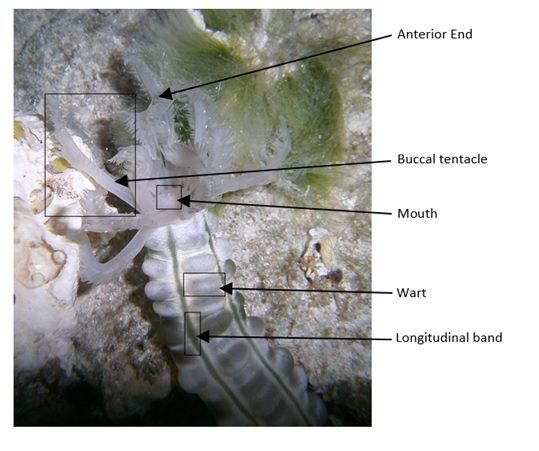Physical Description
Identification features:
Euapta godeffroyi was first described by Semper in 1868. Semper identified six main physical features that can be used to successfully identify E. godeffroyi to the species level from other members of the class Holothuroidea.
The six key identification traits include;
· Elongated body
· Body yellowish in colour, including translucent white aspects
· Multiple dark bands
· 5 radial longitudinal bands - predominately brown lined with yellow
· Mouth surrounded by 15 pinnate (buccal) tentacles
· Buccal tentacles whitish-grey in colour
Size range:
Apodids range in size from a few millimetres to up to 3m (Kerr, 2011). E. godeffroyi can reach up to 2m in length and 2cm in diameter (Semper, 1868). This species readily contracts and expands its body size when threatened or in response to the physical environment, for example rapidly contracting so that it can shelter within small crevices of coral rubble. This rapid contraction was also displayed upon handling. Further, the species, when threatened can rapidly reduce its width so that it is essentially just the thin skin.
Colour and patterns (and variants):
E. godeffroyi, as seen in the photo below, has a mixture of white, green, yellow and grey colouring. The buccal tentacles are greyish in colour. The body is primarily cream/white/yellow in colour, including dark bands and aspects which are translucent white – the colour pattern is not uniform. An identification feature of this species is that it has five longitudinal bands which are predominantly brown and lined with yellow.

Photo: Megan Permyakoff, Heron Island, 2013
Key body plan features (associated with head, body and appendages):
E. godeffroyi has a cylindrical, elongated body plan typical of the holothurian class. A major unique characteristic of this species that distinguishes it from other sea cucumbers is its body wall (integument), which is extremely thin compared to the leathery skin typical of most species within the class. The skin of E. godeffroyi makes it extremely difficult to handle due to the calcareous spicules present in its skin, which cause it to adhere on contact to an objector its environment (See the ‘Anatomy and Physiology’ tab for a more detailed description of the calcareous spicules present and the associated image output of the scanning electron microscopy (SEM) which was conducted).
Characteristic of other members of Echinodermata, E. godeffroyi has pentaradial symmetry and a degree of bilateral symmetry that has evolved due to the regular way they position their body on the substrate. E. godeffroyi lack tube feet, respiratory trees, papillae and radial water canals, all of which are usually characteristic of the class (Kerr, 2011). Respiration is achieved through the skin.
This species features ‘warts’ all over the body, however these ‘warts’ have been suggested to not be an anatomically identifiable structure but instead areas of the body wall surrounded by temporary contractions of the animals circular muscles (Heffernan and Wainwright, 1974).
This species has 15 pinnate tentacles surrounding the mouth, used in deposit feeding. Buccal tentacles can be retracted into the mouth. The buccal tentacles of E. godeffroyi contain up to 80 digits (projections).

Figure 1: Key external features of E. godeffroyi
Distinguishing between physically similar species:
The other species of the genus is Euapta lappa which has a distribution in the Caribbean. Sometimes Euapta godeffroyi can be confused with Synapta maculate, but can be readily distinguished by darker tentacles that are not united by a membrane. Further E. godeffroyi can be correctly identified by the five longitudinal bands that are lined with yellow.
Other scientific names used to describe E. godeffroyi are Synapta godeffroyi and Synapta serpentine, but neither of these names is valid.
|